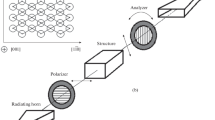Abstract
A simple procedure, based on the transformation properties of the nonlinear susceptibility tensors of different ranks referred to appropriate coordinate systems, is given for studying the selection rules and polarization characters in regard to all orders of harmonics. By this procedure, results covering both linearly and circularly polarized incident light for all the 32 crystal classes with some simplifying restrictions are obtained and listed in the paper. Attention is drawn to special features in each case. There is complete agreement with what has been reported earlier by Tang and Herbert Rabin for circularly polarized incident light.
Similar content being viewed by others
References
Bhagavantam, S...Proc. Ind. Acad. Sci., 1942,16, 359.
- ..Crystal Symmetry and Physical Properties, Academic Press, 1966.
—..Proc. Ind. Acad. Sci., 1972,75, 1.
Maker, P. D., Terhune, R. W. and Savage, C. M.Proc. Third Inst. Conf. on Quantum Electronics, Dumond, Paris, 1964, p. 1559.
Tang, C. L. and Herbert RabinPhys. Rev., 1971,3, 4025.
Author information
Authors and Affiliations
Rights and permissions
About this article
Cite this article
Bhagavantam, S., Chandrasekhar, P. Harmonic generation and selection rules in nonlinear optics. Proc. Indian Acad. Sci. 76, 13–20 (1972). https://doi.org/10.1007/BF03048332
Received:
Issue Date:
DOI: https://doi.org/10.1007/BF03048332




